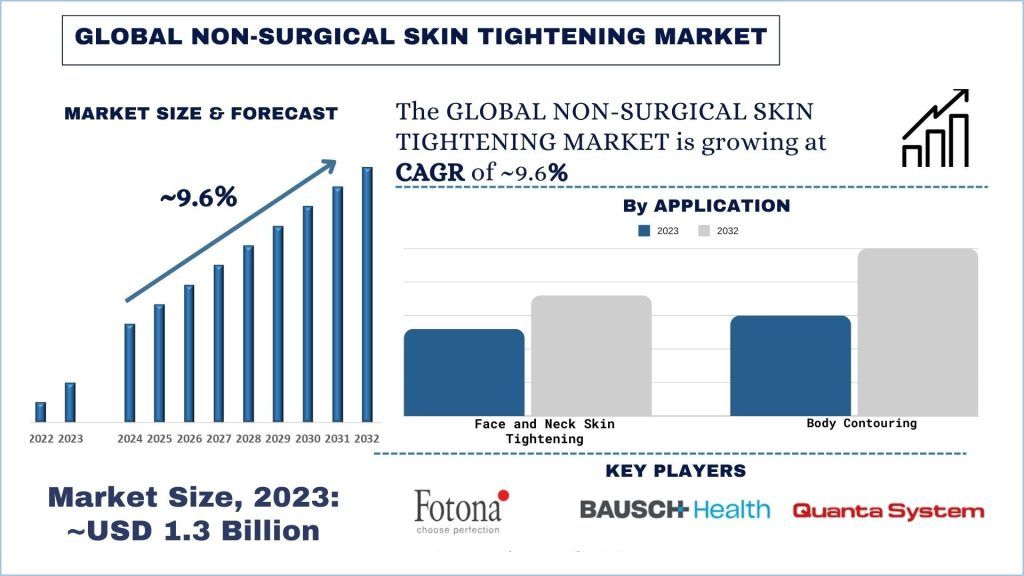- Home
- About Us
- Industry
- Services
- Reading
- Contact Us
Non-Surgical Skin Tightening Market: Current Analysis and Forecast (2024-2032)
Emphasis on Type (Laser-based Aesthetic Device, Radiofrequency (RF) Based Aesthetic Device, Ultrasound Aesthetic Device, and Other); Application (Face & Neck Skin Tightening and Body Contouring); End-User (Hospital, Dermatology Clinics, and Others); and Region/Country
Non-Surgical Skin Tightening Market Size & Forecast
The non-surgical skin tightening market was valued at around USD 1.3 Billion in 2023 and is expected to grow at a strong CAGR of around 9.6% during the forecast period (2024-2032) owing to the rising trend of cosmetic makeovers.
Non-Surgical Skin Tightening Market Analysis
Non-surgical skin tightening techniques employ different technologies to target specific layers of the skin without the need for surgical incisions. These non-surgical methods are generally safe and well-tolerated, with minimal downtime compared to surgical procedures like facelifts or body lifts. Increasing technological advancements have contributed to the higher demand for non-surgical skin tightening.
For instance, in December 2023, U.S.-based Inmode, a leader in cutting-edge aesthetic solutions launched ‘Define’, its latest innovation in facial remodeling technology.
Moreover, in October 2023, the Food and Drug Administration (FDA) approved a new skin-tightening device Sofwave System by Sofwave Medical Ltd., an Israeli-based aesthetic device company. The device is intended to treat facial lines and wrinkles using ultrasound to tighten the tissue below the skin.
Also, according to the International Society of Aesthetic Plastic Surgery in 2022, a total of 755,229 non-surgical procedures were performed in Mexico among which 45,976 were non-surgical skin tightening procedures. The increasing demand for skin tightening procedures is driving the growth of the market during the forecast period.
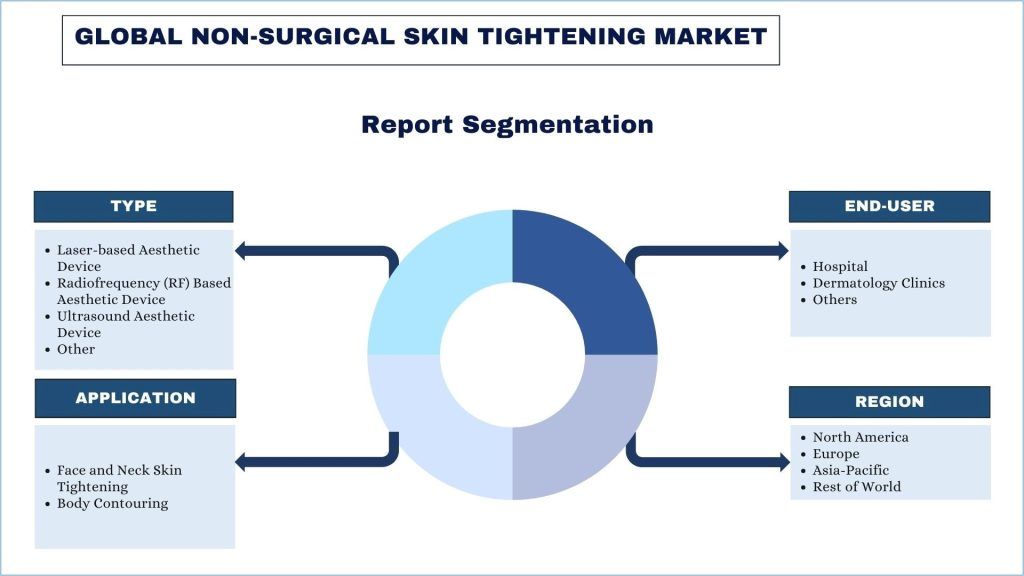
Non-Surgical Skin Tightening Market Trends
This section discusses the key market trends that are influencing the various segments of the Non-Surgical Skin Tightening Market as identified by our team of research experts.
Laser-based Non-Surgical Skin Tightening Transforming Industry
Laser-based aesthetic devices continue to play a significant role in the non-surgical skin tightening market. These devices offer a range of options for patients seeking to improve skin laxity and rejuvenate their appearance without undergoing surgery. Laser technology for skin tightening has seen continuous advancements, leading to the development of more effective and versatile devices. These advancements include improvements in laser wavelengths, energy delivery systems, and targeting mechanisms, allowing for better customization of treatments based on individual skin types and concerns. There is a growing demand for non-surgical skin tightening procedures driven by factors such as increasing awareness of aesthetic treatments, expansion of dermatology clinics, desire for minimal downtime, and advancements in technology leading to safer and more effective procedures. For instance, in December 2021, Laser Clinics, the world’s leading provider of advanced aesthetic treatments, announced the launch of Laser Clinics Asia, a brand-new aesthetic clinic combined with an immersive retail experience.
North America is Expected to Grow with Significant CAGR During Forecast Period
Within North America, the U.S. holds a major share of the market. The major factors boosting the market’s growth in the country are the region’s rapid urbanization, rising technological advancements, the growing trend of skin tightening, affordable procedures, innovative product launches, and the presence of several market players.
In February 2023, iCRYO, the fast-growing recovery and wellness brand announced its synergistic partnership with one of the world’s major medical and aesthetic equipment manufacturers, BTL Industries, for a multi-year contract to allow iCRYO to continue to innovate and expand its capabilities to its fast-growing number of franchises across the U.S.
In September 2022, U.S.-based BTL, the authority in non-invasive body sculpting therapies unveiled its latest innovative product, EMFACE – the first and only hands-free device that simultaneously treats facial skin and muscles without needles in just 20 minutes.
According to the American Society of Plastic Surgeons, average physician fees in the year 2022 for Nonsurgical skin tightening (e.g., Pelleve, Thermage, Ulthera) was USD 1,832.
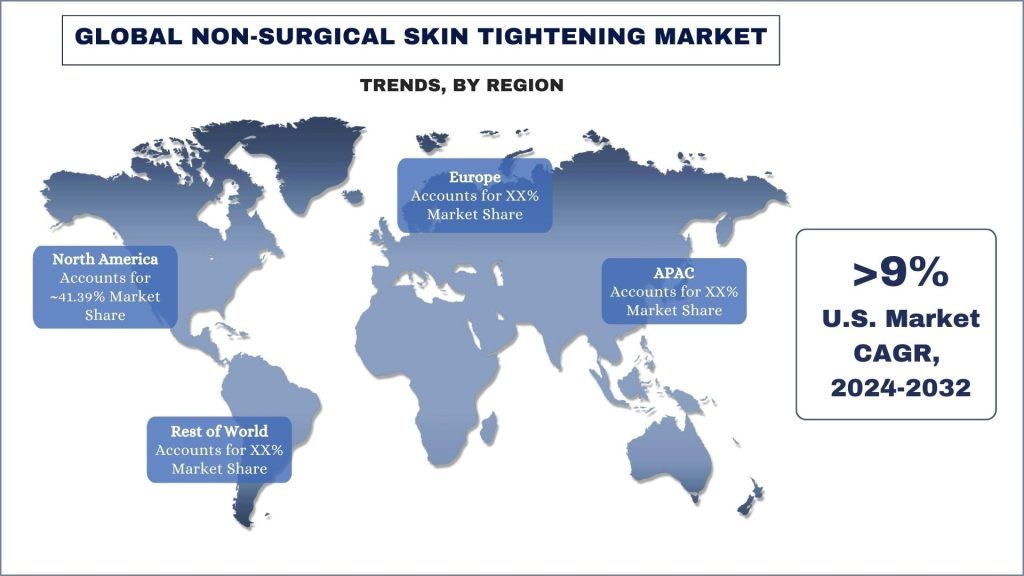
Non-Surgical Skin Tightening Industry Overview
The non-surgical skin tightening market is competitive, with the presence of several global and international market players. The key players are adopting different growth strategies to enhance their market presence, such as partnerships, agreements, collaborations, new product launches, geographical expansions, and mergers and acquisitions. Some of the major players operating in the market are Fotona; Venus Concept; Bausch Health Companies Inc.; Cynosure, LLC; ENDYMED; Quanta System; Lynton Lasers Ltd; Sciton; Sisram Medical Ltd; Lumenis Be Ltd.
Non-Surgical Skin Tightening Market News
In March 2024, Heart Evangelista was made brand ambassador for the latest campaign of Ultherapy, the gold standard in non-invasive skin lifting procedures.
In February 2024, RoC Skincare announced the newest addition to their Derm Correxion line, the Derm Correxion Firming Serum Stick to lift, tighten, and smooth skin instantly and over time. The retinol-based formula, in an innovative and easy-to-apply stick format, glides on clear and evenly massages into the face, neck, chest, and hands.
In February 2024, RoC Skincare announced the newest addition to their Derm Correxion line, the Derm Correxion Firming Serum Stick to lift, tighten, and smooth skin instantly and over time. The retinol-based formula, in an innovative and easy-to-apply stick format, glides on clear and evenly massages into the face, neck, chest, and hands.
In October 2023, Reveal Lasers, a pioneering name in the field of aesthetic technology announced the launch of its latest breakthrough device: Denza, featuring monopolar & bipolar radiofrequency with sequential pulsing technology.
Non-Surgical Skin Tightening Market Report Coverage
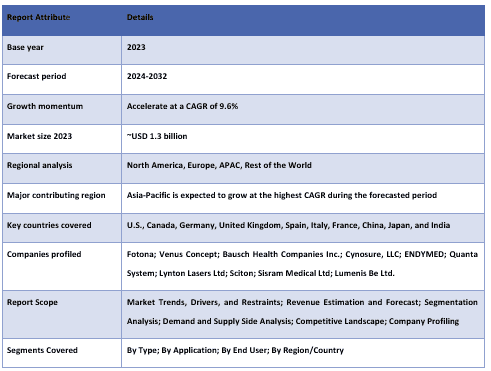
Reasons to buy this report:
- The study includes market sizing and forecasting analysis validated by authenticated key industry experts.
- The report presents a quick review of overall industry performance at one glance.
- The report covers an in-depth analysis of prominent industry peers with a primary focus on key business financials, product portfolios, expansion strategies, and recent developments.
- Detailed examination of drivers, restraints, key trends, and opportunities prevailing in the industry.
- The study comprehensively covers the market across different segments.
- Deep dive regional level analysis of the industry.
Customization Options:
The global non-surgical skin tightening market can further be customized as per the requirement or any other market segment. Besides this, UMI understands that you may have your own business needs, hence feel free to connect with us to get a report that completely suits your requirements.
Table of Content
Research Methodology for the Non-Surgical Skin Tightening Market Analysis (2024-2032)
Analyzing the historical market, estimating the current market, and forecasting the future market of the global non-surgical skin tightening market were the three major steps undertaken to create and analyze the adoption of non-surgical skin tightening in major regions globally. Exhaustive secondary research was conducted to collect the historical market numbers and estimate the current market size. Secondly, to validate these insights, numerous findings and assumptions were taken into consideration. Moreover, exhaustive primary interviews were also conducted, with industry experts across the value chain of the global non-surgical skin tightening market. Post assumption and validation of market numbers through primary interviews, we employed a top-down/bottom-up approach to forecasting the complete market size. Thereafter, market breakdown and data triangulation methods were adopted to estimate and analyze the market size of segments and sub-segments of the industry pertains to. Detailed methodology is explained below:
Analysis of Historical Market Size
Step 1: In-Depth Study of Secondary Sources:
Detail secondary study was conducted to obtain the historical market size of the non-surgical skin tightening market through company internal sources such as annual reports & financial statements, performance presentations, press releases, etc., and external sources including journals, news & articles, government publications, competitor publications, sector reports, third-party database, and other credible publications.
Step 2: Market Segmentation:
After obtaining the historical market size of the non-surgical skin tightening market, we conducted a detailed secondary analysis to gather historical market insights and share for different segments & sub-segments for major regions. Major segments are included in the report as type, application, end-user, and regions. Further country-level analyses were conducted to evaluate the overall adoption of testing models in that region.
Step 3: Factor Analysis:
After acquiring the historical market size of different segments and sub-segments, we conducted a detailed factor analysis to estimate the current market size of the non-surgical skin tightening market. Further, we conducted factor analysis using dependent and independent variables such as type, application, end-user, and regions of the non-surgical skin tightening market. A thorough analysis was conducted for demand and supply-side scenarios considering top partnerships, mergers and acquisitions, business expansion, and product launches in the non-surgical skin tightening market sector across the globe.
Current Market Size Estimate & Forecast
Current Market Sizing: Based on actionable insights from the above 3 steps, we arrived at the current market size, key players in the global non-surgical skin tightening market, and market shares of the segments. All the required percentage shares split, and market breakdowns were determined using the above-mentioned secondary approach and were verified through primary interviews.
Estimation & Forecasting: For market estimation and forecast, weights were assigned to different factors including drivers & trends, restraints, and opportunities available for the stakeholders. After analyzing these factors, relevant forecasting techniques i.e., the top-down/bottom-up approach were applied to arrive at the market forecast for 2032 for different segments and sub-segments across the major markets globally. The research methodology adopted to estimate the market size encompasses:
- The industry’s market size, in terms of revenue (USD) and the adoption rate of the non-surgical skin tightening market across the major markets domestically
- All percentage shares, splits, and breakdowns of market segments and sub-segments
- Key players in the global non-surgical skin tightening market in terms of products offered. Also, the growth strategies adopted by these players to compete in the fast-growing market
Market Size and Share Validation
Primary Research: In-depth interviews were conducted with the Key Opinion Leaders (KOLs) including Top Level Executives (CXO/VPs, Sales Head, Marketing Head, Operational Head, Regional Head, Country Head, etc.) across major regions. Primary research findings were then summarized, and statistical analysis was performed to prove the stated hypothesis. Inputs from primary research were consolidated with secondary findings, hence turning information into actionable insights.
Split of Primary Participants in Different Regions
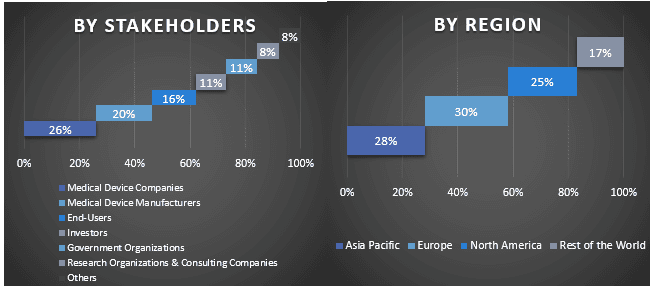
Market Engineering
The data triangulation technique was employed to complete the overall market estimation and to arrive at precise statistical numbers for each segment and sub-segment of the global non-surgical skin tightening market. Data was split into several segments & sub-segments post studying various parameters and trends in the areas of the type, application, end-user, and regions in the global non-surgical skin tightening market.
The main objective of the Global Non-Surgical Skin Tightening Market Study
The current & future market trends of the global non-surgical skin tightening market were pinpointed in the study. Investors can gain strategic insights to base their discretion for investments on the qualitative and quantitative analysis performed in the study. Current and future market trends determined the overall attractiveness of the market at a regional level, providing a platform for the industrial participant to exploit the untapped market to benefit from a first-mover advantage. Other quantitative goals of the studies include:
- Analyze the current and forecast market size of the non-surgical skin tightening market in terms of value (USD). Also, analyze the current and forecast market size of different segments and sub-segments.
- Segments in the study include areas of the type, application, end-user, and regions.
- Define and analyze the regulatory framework for the non-surgical skin tightening
- Analyze the value chain involved with the presence of various intermediaries, along with analyzing customer and competitor behaviors of the industry.
- Analyze the current and forecast market size of the non-surgical skin tightening market for the major region.
- Major countries of regions studied in the report include Asia Pacific, Europe, North America, and the Rest of the World
- Company profiles of the non-surgical skin tightening market and the growth strategies adopted by the market players to sustain in the fast-growing market.
- Deep dive regional level analysis of the industry
Frequently Asked Questions FAQs
Q1: What is the non-surgical skin tightening market's current market size and growth potential?
Q2: What are the driving factors for the growth of the non-surgical skin tightening market?
Q3: Which segment has the largest share of the non-surgical skin tightening market by type?
Q4: What are the emerging technologies and trends in the non-surgical skin tightening market?
Q5: Which region will dominate the non-surgical skin tightening market?
Related Reports
Customers who bought this item also bought

